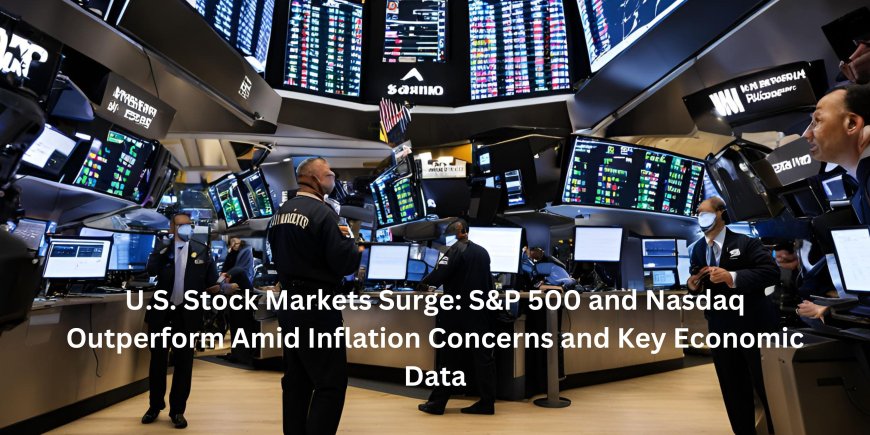U.S. Stock Markets Surge: S&P 500 and Nasdaq Outperform Amid Inflation Concerns and Key Economic Data
Discover how the S&P 500 and Nasdaq indices are showing strong performance amid rising inflation concerns and upcoming key economic data releases, including the Federal Reserve's PCE price index, Q1 GDP growth, and May home sales.

U.S. Stock Markets Show Robust Performance Amid Economic Data and Inflation Concerns
The U.S. stock markets have exhibited notable resilience and buoyancy, particularly with the S&P 500 and Nasdaq indices demonstrating strong performance. Investors are keenly monitoring a range of economic indicators, with particular focus on the Federal Reserve's preferred measure of inflation, the Personal Consumption Expenditures (PCE) price index. Additionally, upcoming economic data, including the revised estimate of Q1 GDP growth and May home sales, are crucial in shaping market expectations and strategies.
Strong Performance of S&P 500 and Nasdaq
The S&P 500 and Nasdaq indices have been standout performers in recent trading sessions. The S&P 500, a benchmark for U.S. equities, has experienced significant gains, driven by robust corporate earnings and positive investor sentiment. The technology-heavy Nasdaq has also seen strong upward momentum, reflecting the continued growth and resilience of the tech sector.
Key factors contributing to this performance include:
-
Corporate Earnings: Many companies have reported better-than-expected earnings, which has boosted investor confidence. Strong earnings reports from major tech companies like Apple, Microsoft, and Alphabet have been particularly influential in driving Nasdaq's performance.
-
Economic Recovery: The U.S. economy has shown signs of steady recovery from the impacts of the COVID-19 pandemic. Employment figures have been improving, and consumer spending has remained strong, contributing to overall economic optimism.
-
Monetary Policy: The Federal Reserve has maintained a supportive stance with its monetary policy, keeping interest rates low and continuing its asset purchase program. This has provided a favorable environment for equities.
The Federal Reserve's Preferred Inflation Measure: PCE Price Index
The Personal Consumption Expenditures (PCE) price index is a critical indicator for understanding inflation trends in the U.S. economy. Unlike the Consumer Price Index (CPI), which measures out-of-pocket expenses, the PCE price index considers changes in the prices of goods and services consumed by individuals, regardless of who pays for them. This broader scope makes the PCE a preferred measure for the Federal Reserve when assessing inflation.
Recent Trends in PCE:
- Rising Inflation: Recent data has indicated an uptick in the PCE price index, reflecting higher costs for goods and services. This rise in inflation has sparked concerns among investors about potential changes in monetary policy.
- Fed's Response: The Federal Reserve has acknowledged the rise in inflation but has maintained that the increase is likely transitory. Fed officials have pointed to supply chain disruptions and pent-up demand as temporary factors driving inflation higher.
Upcoming Economic Data: Q1 GDP Growth and May Home Sales
Investors are also closely watching upcoming economic data releases, which are expected to provide further insights into the health of the U.S. economy.
Revised Estimate of Q1 GDP Growth:
- Initial Estimate: The initial estimate for Q1 GDP growth showed robust economic expansion, driven by consumer spending and government stimulus.
- Revised Estimate: The revised estimate will provide a more accurate picture of economic activity in the first quarter. Analysts expect the revised data to confirm strong growth, but any significant revisions could influence market sentiment.
May Home Sales:
- Housing Market Trends: The housing market has been a key driver of economic growth, with low mortgage rates and high demand leading to increased home sales and rising prices.
- May Sales Data: The upcoming data on May home sales will shed light on recent trends in the housing market. Investors will be looking for signs of continued strength or any indications of cooling off, which could impact broader economic forecasts.
Market Reactions and Investor Sentiment
The strong performance of the S&P 500 and Nasdaq, coupled with closely watched economic indicators, has led to a mix of optimism and caution among investors.
Optimism:
- Positive Earnings: Continued strong corporate earnings have fueled optimism about the health of the business sector and its ability to navigate challenges.
- Economic Recovery: Signs of sustained economic recovery, including improving employment figures and robust consumer spending, have bolstered confidence in the market.
Caution:
- Inflation Concerns: Rising inflation remains a key concern for investors. The potential for higher prices to persist could lead to changes in monetary policy, such as an earlier-than-expected increase in interest rates.
- Economic Data: Upcoming economic data releases, including the PCE price index, Q1 GDP growth, and May home sales, are being closely watched for any signs of economic overheating or slowdown.
Strategic Implications for Investors
Given the current market conditions and economic outlook, investors are adopting various strategies to navigate potential risks and opportunities.
Diversification:
- Sector Rotation: Some investors are rotating into sectors that are expected to benefit from economic recovery, such as financials, energy, and industrials. This approach aims to capitalize on sectors that may perform well in a growing economy.
- Tech Focus: Despite concerns about high valuations, the technology sector continues to attract investment due to its strong growth prospects and resilience.
Risk Management:
- Hedging: To mitigate potential risks from market volatility and inflation, investors are employing hedging strategies, such as options and futures, to protect their portfolios.
- Quality Stocks: Focusing on high-quality stocks with strong fundamentals and stable earnings can provide a buffer against market fluctuations.
Monitoring Economic Indicators:
- Inflation Data: Keeping a close eye on inflation data, particularly the PCE price index, to gauge potential impacts on monetary policy and market conditions.
- Growth Indicators: Monitoring GDP growth and other economic indicators to assess the sustainability of the economic recovery and adjust investment strategies accordingly.
Conclusion
The U.S. stock markets have shown remarkable buoyancy, with the S&P 500 and Nasdaq indices reflecting strong performance driven by corporate earnings, economic recovery, and supportive monetary policy. However, the landscape is not without its challenges, as investors remain vigilant about rising inflation and the implications for future monetary policy. Upcoming economic data, including the revised estimate of Q1 GDP growth and May home sales, will be crucial in shaping market expectations and guiding investment decisions.
In this dynamic environment, investors are balancing optimism with caution, adopting diversified strategies and closely monitoring economic indicators to navigate potential risks and capitalize on opportunities. As the market continues to evolve, staying informed and adaptable will be key to achieving investment success in the months ahead.
References
- Livemint: Stock Markets Today Live Updates
- MarketWatch: U.S. Stock Market News
- Federal Reserve: Personal Consumption Expenditures (PCE) Price Index
- CNBC: Economic Data and Market Performance
- Reuters: U.S. Economic Indicators

 LD Web Desk
LD Web Desk 